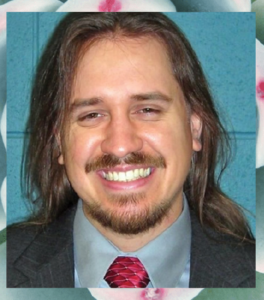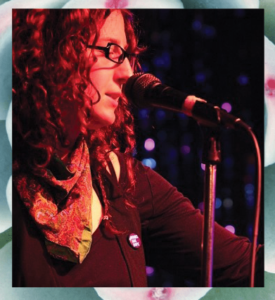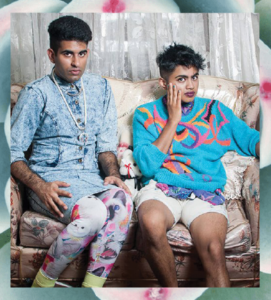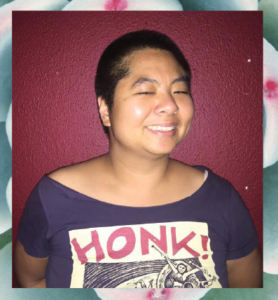Note: We are two cisgender writers conveying our understandings of these poems, and in no way mean to misrepresent the poets’ intentions or extrapolate about their lives.
“We need poetry when literal faces and bodies and circumstances are not as good as it gets: we might enjoy reading and writing poetry for many reasons, but we need it when we feel that we need figuration, need something unavailable in the literal world.”
Thus says Stephen Burt in “The Body of the Poem: On Transgender Research.” In many ways, this quote highlights the complex and important role that poetry plays in the lives of transgender individuals. Here, Burt argues that poetry creates a personal and political space – it promotes the visibility of trans voices and trans experiences. It also creates a new “body,” a place where trans people can explore their intersecting identities and a place where they can explore concepts of gender, self and identity (and a myriad of other topics) that is larger than life. In Troubling the Line, a book of poetry Burt is featured in, several poems use the language of “experiment.” According to Burt, the trans poets contributing to this book see it as a way of experimenting through writing; challenging identity categories and assumptions that come with the gender binary.
For other trans writers, poetry is important as a medium because it represents accessibility. In an interview with The Guardian, trans writer Lilith Latini said that trans poetry, unlike other forms of writing, has two benefits: there is less pressure to focus on universal narratives and there is more room to talk about everyday life. Latini says, “Everything about trans people [used to be] focused around a tragic stereotype. With more recent trans writing it’s different. Performing for a trans audience instead of a cis audience, it’s less about the tragedies of one’s life, but instead the everydayness, the really bittersweet normality of it.” There are other significant ways in which poetry provides more accessibility than academic writing or personal writing in the form of memoirs and books – sometimes it is simply easier to start by having one poem published. Poetry is also an accessible medium in that it is free of jargon and the barriers that of academic writing. While medicalization is a theme that several trans poets choose to discuss, poetry offers a medium to talk about hormones, surgery and hospital bills free of jargon, legal terms, and standard narratives of seeking medical care.
This post will explore the different ways in which poetry serves as a tool for trans writers, and will discuss several specific themes in depth such as trans antagonism and the violence faced by trans people, intersectionality, and resilience and healing. Throughout, we will also be featuring texts from some of these poems.
Trans Excellence
We intentionally wanted to start with the important theme of trans excellence to combat the notion that all trans experiences must be told through a lens of violence and oppression, and that the only trans stories worthy of a mainstream audience are ones that fit this narrative. Trans excellence is also a concept that several trans academics, and activist and author Janet Mock, discuss in their work. As Mock puts it, trans excellence can be affirmation that trans individuals are capable of success, it can be affirmation and validation from peers, and it can be claiming historical events such as the participation of trans women in the Stonewall riots as an excellent and awe-inspiring element of identity.
One poet who discusses this theme is Joshua Jennifer Espinoza. In the poem “Two Poems” Espinoza describes feeling proud over her identity as a woman and how “everyone hates” what she thinks are the coolest parts about herself – but that’s cool. She writes:
the second coolest thing about me is how gay i am.
the coolest thing about me is that i am a woman.
everything i love about myself is everything
we are taught to hate and disregard.
how cool is that?
i’m a sculpture of a goddess
accidentally carved into the side of a cliff
by millions of years of pounding ocean waves
so much pain and salt
so much water and life.
hell yeah.
Here, it is worth celebrating that she exists in identities that she loves, even though they might not be celebrated by the public. She also discusses herself in positive terms, she is a “sculpture of a goddess …. Hell yeah.” This celebration of trans identities and this perseverance despite backlash and discrimination is important and an element of using poetry to create personal and political spaces for trans authors to find community and challenge norms about gender. Later on in the same poem, Espinoza writes “I used to want to die every day / but now I want to live,” demonstrating the importance of healing, and also challenging tropes that trans people live in a constant struggle with their bodies, gender identities and in a state of dysphoria.
Trans Antagonism and Violence
A common theme in many poems by trans writers is trans antagonism and violence. It’s sadly unsurprising that this is the case; according to a 2017 Human Rights Campaign and Trans People of Color Coalition study, “transgender women are estimated to face more than four times the risk of becoming homicide victims than the general population of all women.” The number of trans victims of fatal violence has risen since 2013, with most of those victims being trans individuals of color. This horrifying violence seems to often inspire trans poets who have faced violence and antagonism themselves, or that of trans individuals like them. Poetry can certainly be a means to contemplate the horror and sorrow of this violence in an artistic way.
Ahimsa Timoteo Bodhrán, a poet and Ph.D. candidate at Michigan State University, expresses anger and sorrow over trans antagonism in the poem “Cycle undone” in Troubling the Line (24-30). The poem was written “for transsexual and transgender women of colour,” exploring transitioning, violence, and fear.
Bodhrán’s poem discusses prejudice trans individuals face, particularly because of the cisgender gaze and normative conceptions about the human body: “We are ‘special.’ Half-off. Up for grabs. The / breast. Ass. Dick-cunt. Cunt-dick. Anything for viewing / pleasure, a topic to be analyzed and discussed, / dissected, gained tenure on. …”

Further, Bodhrán makes it clear that discrimination is not only a personal experience, but a systemic problem as well. Bodhrán writes: “We are not glamourous. We are overworked / and poor. We have no jobs. Even our children / are taken from us, turned against us (upon / transitioning, prior, years later, and before).”
The poem later explicitly mentions violence – particularly fatal violence – against trans folx. These lines reference the aforementioned violence rates against trans individuals, as well as the overall negligence law enforcement has towards trans victims. “We are the uninvestigated murders of our Nations, / the bodies in the river, field, fed on by fishes, crows…” Here Bodhrán’s distaste for the lack of attention to trans antagonism and violence comes through clearly; they clearly express that these is a problems in all nations, and one that leads directly to the loss of lives.
As Bodhrán also discussed in “Cycle undone,” trans poetry often critiques the antagonistic nature of some discourse perpetuated by cisgender individuals. In “Makeup Ritual” by poet Joshua Jennifer Espinoza she discusses trans antagonism that comes from trans-exclusionary “feminists” (also known as TERFs) who doubt and disrespect the legitimacy of trans women’s identities and experiences. TERFs argue that trans women are dangerous, perpetuating misogyny through “infiltrating” women’s bodies, or that their identities or some type of sexual fetish.

Espinoza reflects on trans-exclusionary ideas in “Makeup Ritual.” The type of trans antagonism perpetuated by TERFs might not be as outwardly violent as the physical abuse many trans folx face, but their trans antagonistic discourse similarly hurts individuals while perpetuating toxic ideas about gender and staticity. Espinoza writes:
“According to some I exist only to
reinforce gendered violence —
my body a blade sliding up and down
the legs of real women
forcing its way under their arms
and carving the language of misogyny
into every surface.”
Similarly, Espinoza wrote the poem “Pardon My Gender” to challenge why TERFs and similarly trans antagonistic individuals struggle, or refuse, to understand trans lives and identities.
“Pardon my gender —
I didn’t mean to make you
question the nature of our reality
or the walls that surround us and
demand we be one thing or the other…”
Thus, Espinoza’s poetry not only laments the discrimination trans folx face on a daily basis, but also asks the reader to ponder as to why trans individuals face such antagonism in the first place. Espinoza’s piece critiques the binary societal understanding of gender as well as locating trans antagonism in a realm of cisgender fear and discomfort.

Medicalization
Another common theme that comes up in trans poetry is the medicalization of trans lives and experiences. Poet Aimee Herman uses her
poetry to create further discourse on the medicalization of trans bodies. In her poem “Poetics Statement,” found in Troubling the Line, Herman writes: “How much am I willing to pay out of pocket for this body?” This line is repeated 11 times, emphasizing, we think, the dilemma of deciding to pay for the body you want, and how difficult a decision that would be. These lines not only speak to the medicalization of the body, but also the privilege of being able to afford (and have access to) bodily modification. This does not just apply to medical “treatments” like sex reassignment surgery or hormones, but also to other bodily modifications (like makeup and tattoos, which Herman also mentions in these poems, for example).
Alok Vaid-Menon, one of the performers from the poetry duo DarkMatter, also discusses the complicated relationship many trans people have with the medical community. In their poem “the bible belt”, Vaid-Menon locates the clinic as a space for invasions of privacy, but also notes it as a space for medical care that might be necessary for medical reasons (and not just those that are gender-identity related). Here are a few particularly poignant lines that reference these themes:
“i am sitting in the waiting room to see a chiropractor
ostensibly to diagnose the chronic back pain that i have developed this past year
but judging from the middle age women in the waiting room
i think this is also a place to be touched
to experience the intimacy of taking off stranger
and letting a man touch you
as if he cares…
“you see,
in this town certain acts of transgression are permissible
when they are covered by health insurance or
have a bible quote to justify them
(is there a difference?)…
“doctor the only accident in my life was when they
proclaimed me both ‘boy’ and ‘brown’ at my birth
and i have been trying to recover from ever since
the thing about this body is that you will use words
‘anxiety’ and ‘pressure’ to diagnose this pain
instead of ‘race’ and ‘gender’ and all of the other words
that never made it into your bibles or medical textbooks”
Intersectional Oppression
The last few lines of Vaid-Menon’s aforementioned poem “bible belt” speak to our next theme from trans poetry is intersectional oppression. All trans poets have a multiplicity of identities, many of which are met with different types of discrimination. Specifically we noticed that many of these poets discuss racial oppression.

DarkMatter’s, which consisted of Alok Vaid-Menon and Janani Balasubramanian during the duo’s existence, poem “White Fetish” approaches the issue of racism in a somewhat jovial light, yet the two make it clear that casual racism is not a laughable issue. “White Fetish” critiques the common white fetishism of people of color, specifically that of people of (South) Asian cultures. This poem mocks white liberals whose privilege allows them to ignore systemic oppression and racism that is an everyday problem for many people of color.
“I’ve heard that white men have huge… / Empires / I’ve heard they’re really good… / at gentrification …
“later that night, you will pull me aside and take nude photos of me like that time you randomly selected me from the airport security checkline / I loved that! …
“I will call you master, because colonialism never had a safe word / You will whisper tenderly in my ear / Don’t worry, I’m not racist like them… / Then fuck me like you are!”
Janani Balasubramanian, the other member of DarkMatter, also discusses classism, racial oppression, and also a mention of body image and (trans) medicalization. Balasubramanian writes in their solo poem “fairy tale”:
“This is the way of things.
This is how love works.
The pilgrims loved the land
so they stole it.
We loved Brooklyn
so we gentrified it.
Our parents loved us
and they messed us up.
I learned to love my body
and then I took a needle to it.”
Once again, this piece of trans poetry discusses the violence of gentrification as well as American colonialism which unjustly displaced Native Americans on their own lands. Balasubramanian also discusses their distrust of love in all forms because it has been used as an excuse to perpetuate forms of violence and oppression. The focus on that poem is not on Balasubramanian’s gender identity, but other issues of oppression that equally disrupt their life and the lives of other marginalized individuals.
Ching-In Chen is another trans poet who uses her work to challenge the oppression of people of color. Chen is a Chinese-American poet and community organizer whose art serves a political purpose. In an interview posted on Chen’s site (linked above), she speaks to how her identities overlap and how that affects her ability to work as a poet: “As a queer woman, as an Asian-American woman, and even as a poet, it’s disheartening to see how many of the presses that published our work have folded over the years or how the people behind them get burned out from that work.”

Chen created a video-poem called “we will not be moved!” in tribute to the Chinese-American community in Oakland, California, who were unjustly evicted from their housing as a result of gentrification. This poem, like the work of Vaid-Menon and Balasubramanian, captures the injustice faced by people of color. Part of the poem reads: “[There are some Asian Americans] who surround themselves with suburban, cream-filled walls, doorways blocking the daily battle cries of their people / who cannot ignore one another, or sit in isolation and slowly die.” The lines highlight the racial violence and difficulties posed by gentrification, a common theme amongst trans poets as we can see.
Another poet, Eli Clare, writes about his intersecting identities of transness and disability. Clare, a genderqueer individual who often writes about growing up in rural community, his activist work, his experiences with disability and his genderqueer identity often turns to poetry to explore themes of the intersecting oppression that he faces. One of Clare’s poems “And Yet” discusses his everyday experiences facing street harassment for being visibly disabled. Clare writes:
Crip skin,
white skin:
which stories
do I tell the best,
and which
rarely begin—
turn, flutter,
Settle?
Earlier in “And Yet,” Clare portrays a scene where he’s walking down the street and a passerby repeatedly shouts a slur at him, mocking him for his disability. This poem also looks at the privilege that he gains from his whiteness, as earlier in the poem he says “crip skin marked/white skin not” referring to the slur he had just been addressed with. He acknowledges that in terms of street harassment, he is not affected by racial comments, but he is affected by another element of his identity, his disability. This poem is just one of many that Clare writes that explore the multiplicity of his identity.
Technology and Fantasy
Similar to the work of other trans artists like Micha Cardenas in their performance art piece called “Becoming Dragon,” many trans poets explore themes of science, technology, and fantasy in their poems. Poetry as an art form and as a tool of exploration seems to become a way for trans authors to understand their own identities in metaphorical ways. The following poems highlight how trans poets use technology and fantasy to analyze their gender and positionality in cisnormative society. Science fiction, technology, and fantasy become themes that represent some trans individuals’ experiences.

Poet Aimee Herman uses coding language as a method of conveying her trans experience, especially in a poem titled “i/dentity (packed)” which specifically refers to her experience as a gender non-conforming child. This poem is from the book Troubling the Line (pages 36-7).
“: call me deviation / .,<} /\| 00—{} / inter / SEX / between legs a fist rises / MUTINY”
Here, coding language allows Herman to express her feelings of alienation in a non-explicit, disjointed manner. Her poetry, like her lived experience, is complicated and perhaps contains emotions that are difficult to express in common parlance. Her understanding of her trans identity is best conveyed through means that emphasize the role of technology in “coding” our gendered lives. In this same poem, Herman describes her experience in a way that highlights the artificial, technological feeling and construction of gender and the gender binary.
“ : when (I) was six, (I) tore out a section of my neck where the label sat. where the label rubbed. where the label pushed pink where there was yellow. where the label reconstructed [my] structure. where the label took away sensation. where the label told {me} how to pee. where the label disguised {me}. Discussed {me}. DISgusts {me}.”
We take the pronouns in brackets here to convey that this is an experience for all children / individuals and especially gender non-conforming children. The pronouns can be replaced by anyone’s, because the construction of gender identity is an experience applicable to anyone. In this way, Herman’s poem represents her experience in a way that is unique – through technological language – but also in a manner that conveys a larger message about gender identity and the oppressive nature of forced biologically-based gendering.
Fantastical and supernatural themes operate similarly to technology metaphors in trans poetry. Conceptualizations of the self are expressed through a non-normative framework that allows poets to escape limits of language and the body (through technology) and escape realist constraints (through fantasy). A great example of the use of supernatural metaphor to explain trans experience can be found in Ari Banias’ poem “Who Is Ghost” in Troubling the Lines (55-6).
“who is ghost, is the translucent almost
who is flotilla, is footless
is died and come back, who is sheet
and oooo is remembered…
forgotten is ghost
the ones with different names now
the girl they say became who is he”
Resilience and Healing
A very important theme in many poems by trans authors is resilience – fighting back and thriving under oppression – and healing. Most of the previous themes represent the pain, struggle, or discomfort facing trans individuals. However, we think it is important to convey that, while it is irresponsible and dangerous to ignore the discrimination and violence targeted towards trans people, it is similarly problematic to ignore trans excellence and resilience. This theme is especially important in poetry as an art form, because reading or writing poetry, although not the sole way to heal, has “significant potential” to aid those who have faced injustice.
Joshua Jennifer Espinoza explores the act of trans resilience by beautifully arguing that the moon is trans. “The Moon is Trans” is directed towards a cisgender audience, and particularly one that does not approve of trans women like Espinoza. Like in her previously referenced poems, Espinoza uses her art to challenge normative conceptions of gender.
“The moon is trans.
From this moment forward, the moon is trans.
You don’t get to write about the moon anymore unless you respect that.
You don’t get to talk to the moon anymore unless you use her correct pronouns.”
This poem defies cisnormative assumptions that the natural world. The poetic deployment of the moon as a trans figure contrasts the trans antagonistic argument that society does not have space for trans individuals and identities. Espinoza’s poem frames something natural and familiar – the moon – as a trans woman, indicating that transness is natural, and perhaps as existing as long as the celestial body itself.
We understand this poem as an act of resilience. By challenging conceptions of “natural” binary gender, Espinoza resists using a normative framework in the first place. She does not suggest that this is her understanding of the world; she states the moon’s gender definitively. She opens with: “The moon is trans.” Espinoza does not ask for her cisgender audience to believe her, she presents her argument as fact, and disallows “you” to disrespect a trans identity.

Linked with this concept of resilience is the concept of hope. Whether it be hope for healing, hope for legislative and social progress, hope for a brighter future or hope for a radical love, hope is a powerful theme explored by several trans poets who use their words to inspire this feeling in their own lives and in the lives of other trans people. Like Espinoza, Clare writes poems to instill this hope. In 2016, Clare spoke at a Transgender Day of Remembrance ceremony held at the Pride Center of Vermont. He addressed the crowd, acknowledging the grief and fear that many in the room felt. However, he started out by reading a poem “Fierce, Fierce Love” because he said he wanted to invoke hope for the future. What’s interesting about this is that he not only read the poem at the beginning, but throughout his speech and also at the end. Clare writes:
When the watermelon come ripe
And cicadas drum the field
When cicadas drum the fields
And we break the rind
When we break the rind
And eat the fruit in chunks
When we eat the fruit in chunks
And juice streaks our shirts
When juice streaks our shirts
Let hope trace our tongues
This poem does not specifically address Clare’s genderqueer identity, or acknowledge any form of grief or oppression, but it still is powerful in that it invokes hope in it’s everydayness and in its repetition. This also signifies how poetry is a powerful medium for trans people in that it allows a celebration of a certain mundanity. This poem is also an act of resilience because it challenges the notion that all trans poetry has to explicitly reference the transness of the author or the violence and struggles that transgender individuals face.
Speak Your Mind